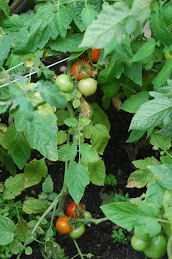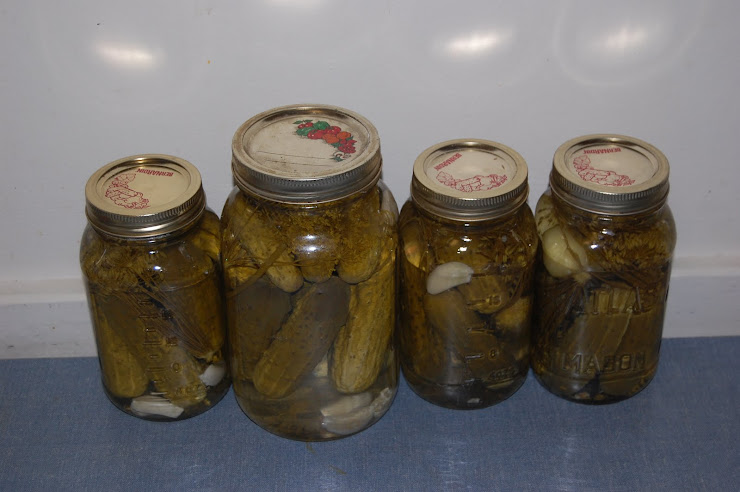
While it hasn't exactly been wintery around here, there's still more days than not when it's much nicer to stay warm and dry indoors, which that gives me plenty of opportunity for catching up on reading. Lately I've been devouring books like there's no tomorrow and coincidentally, quite a few of them have been about the possibility of there being no tomorrow.
Post apocalyptic fiction is a fairly popular genre these days. TEOTWAWKI is subject that is on a lot of people's minds and as much as I claim to not believe wholeheartedly in theories like Peak Oil, I obviously can't help but think we all would be better off if we were a little more prepared for whatever possible disaster may strike. So I understand why I and others like me are drawn to these stories- we want to see how other people imagine what life would be like and how humanity would survive if the worst did happen. The problem for me with most stories of this genre is that they tend to fall into one of two plot lines; either the entire story is too devoted to conflict (wars with rival gangs/armies, way too detailed information about weapons- the worst of these was written by a woman and I've managed to forget both her name and the title thankfully) or they become personal fantasies with obvious sexual overtones-(James Kunstler, I'm looking at you.) I had high hopes for Dies the Fire ( part one of the Emberverse series) by S.M. Stirling, but it sadly ends up falling into both traps. The first part of the book reads like a library list of people with the skills we'd need to survive (the ones who will survive are ex-marines and Renaissance Faire/historical re-enactment actors? If so I hope to die in the first wave!) The second part spends way too much time detailing how to make and use bows, swords and chain mail while building towards the stereotypical battle between the good (lead by a Celtic musician/Wiccan priestess), and the bad- bike gangs and criminals led by a generic psychotic genius. By the time the actual conflict peaked in part three I cared so little about any of these people that I was secretly hoping for total annihilation. Where's a tsunami when you need one?
Don't get me wrong, I realize that you need some kind of conflict to make a story interesting, otherwise it just reads like a how-to manual but it would be nice if it didn't always deteriorate into good versus evil. With all the technology gone, wouldn't man vs nature be enough of a conflict to make for an interesting read? Or even some rogue pigs or vampire cats for added drama? On that thought I'll head back to non fiction so we can all be better prepared for the zombie apocalypse, solar flare or whatever disaster awaits us .
The good folks at Thomas Allen and Son sent me a few new titles to have a look at and these are the ones I was particularly impressed with.
Frugavore; How to Grow Organic,Buy Local, Waste Nothing and Eat Well, by Arabelle Forge. By the title alone you can guess this book was right up my alley. At first it seemed like I'm already doing pretty much everything she writes about so it felt a bit like preaching to the choir. But when I got to the section on meat however, I found the info on curing bacon which was something I'd wanted to try, and then I found the recipe for marrow on toast, oh yum! It also has a great section on baking with sourdough, another thing Id like to try, and some really great info and recipes for home dairy. Overall this book is full of great knowledge and advice as well as really useful recipes, great for beginners and old hands alike!
Small Green Roofs: Low-Tech Options for Greener Living, by Nigel Dunnett, Dusty Gedge, John Little, and Edmund C. Snodgrass. If you've ever thought about having a green roof but don't have the access or the means to build one on your home, consider a small green roof on your garage! Or your porch roof, your tool shed, or even a birdhouse! This book is full of great ideas, beautiful photos and over 40 detailed plans on how to convert just about any roof or flat surface into a potential growing space. Many of the projects in this book are located in Sheffield, England- I wish I would have read this book prior to my visit there last summer- but are adaptable to anywhere. I wonder how my landlord would feel about a green roof on the sunporch?

 The Year Round Vegetable Gardener by Niki Jabbour. My first thought when I saw this book was that she likely lives some place warm like California or Australia but then I noticed snow in some of the photos! I was delighted to realize she's actually from Halifax (Nova Scotia) which gets a heck of a lot colder than here, not to mention the freak weather patterns like hurricanes. The book is beautifully laid out with great photos of things like people digging parsnips out from under the snow. The information is logically organized and includes lists of seed varieties that are good for cold weather and/or short growing seasons. There's even a wonderful chart that lists the amount of daylight hours on Dec 21 (winter solstice) by region (North American). I've been using for suggestions of cold weather crops which I can start right now inside our greenhouse at work!
The Year Round Vegetable Gardener by Niki Jabbour. My first thought when I saw this book was that she likely lives some place warm like California or Australia but then I noticed snow in some of the photos! I was delighted to realize she's actually from Halifax (Nova Scotia) which gets a heck of a lot colder than here, not to mention the freak weather patterns like hurricanes. The book is beautifully laid out with great photos of things like people digging parsnips out from under the snow. The information is logically organized and includes lists of seed varieties that are good for cold weather and/or short growing seasons. There's even a wonderful chart that lists the amount of daylight hours on Dec 21 (winter solstice) by region (North American). I've been using for suggestions of cold weather crops which I can start right now inside our greenhouse at work! From my stack of library books, I've a couple favourites as well, historical of course, one fiction and one non.
Year of Wonders: A Novel of the Plague is a fictionalized tale based on Eyam, an actual town in England during the the time of the black plague. According to history the plague came to this small village in 1666 and since it was already somewhat isolated in the hills of Derbyshire, the residents agreed to quarantine themselves to prevent the disease from spreading further. Told through the eyes of Anna Firth, the fictional house maid to the Rector and his wife, and incorporating some of the actual details known of the events of that year, the book is a moving portrayal of life in the time of the black death.
 The Wilder Life: My Adventures in the Lost World of Little House on the Prairie. Wendy Mcclure went looking for remnants of the life and journeys of Laura Ingalls Wilder and along the way found more and less that she'd hoped for. Reading this book made me remember all over again how much I loved the Little House books and how much they still affect me today. I need to go reread them and see if I figure out how to make a button lamp!
The Wilder Life: My Adventures in the Lost World of Little House on the Prairie. Wendy Mcclure went looking for remnants of the life and journeys of Laura Ingalls Wilder and along the way found more and less that she'd hoped for. Reading this book made me remember all over again how much I loved the Little House books and how much they still affect me today. I need to go reread them and see if I figure out how to make a button lamp!And that's just the tip of the iceburg that is my reading pile. I hope to make Book Review Fridays a regular thing and I'd love it if you posted some of your favourites and suggestions here, because in my version of the zombie apocalypse, it's the librarians who are going to survive TEOTWAWKI (the end of the world as we know it)!

































.jpg)



